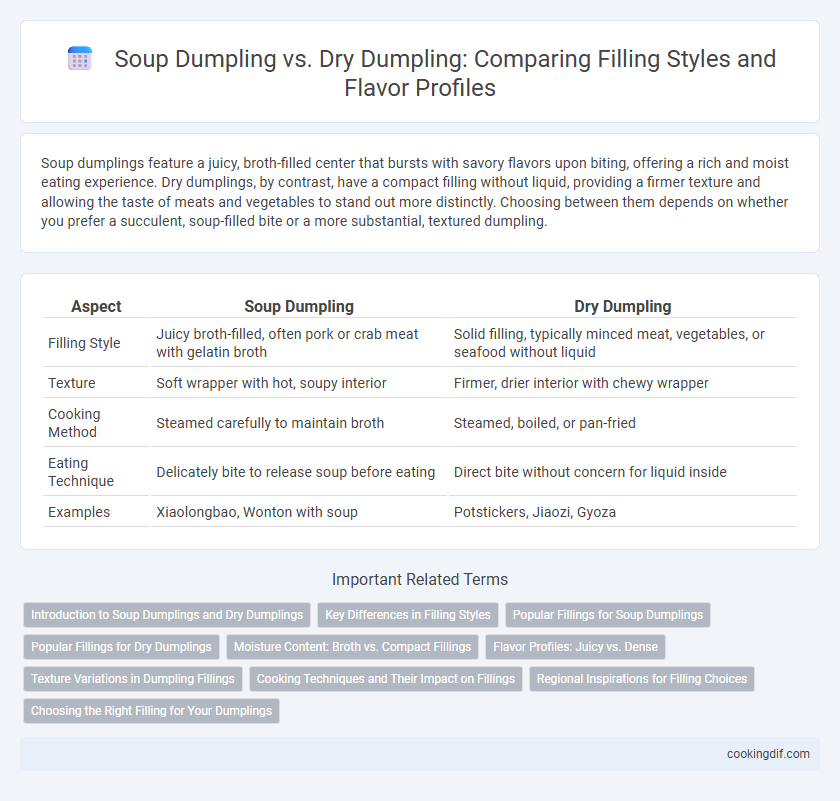Soup dumplings feature a juicy, broth-filled center that bursts with savory flavors upon biting, offering a rich and moist eating experience. Dry dumplings, by contrast, have a compact filling without liquid, providing a firmer texture and allowing the taste of meats and vegetables to stand out more distinctly. Choosing between them depends on whether you prefer a succulent, soup-filled bite or a more substantial, textured dumpling.
Table of Comparison
| Aspect | Soup Dumpling | Dry Dumpling |
|---|---|---|
| Filling Style | Juicy broth-filled, often pork or crab meat with gelatin broth | Solid filling, typically minced meat, vegetables, or seafood without liquid |
| Texture | Soft wrapper with hot, soupy interior | Firmer, drier interior with chewy wrapper |
| Cooking Method | Steamed carefully to maintain broth | Steamed, boiled, or pan-fried |
| Eating Technique | Delicately bite to release soup before eating | Direct bite without concern for liquid inside |
| Examples | Xiaolongbao, Wonton with soup | Potstickers, Jiaozi, Gyoza |
Introduction to Soup Dumplings and Dry Dumplings
Soup dumplings, known as xiaolongbao, feature a delicate, thin wrapper encasing savory broth and tender meat filling, delivering a burst of flavorful soup with each bite. Dry dumplings, by contrast, contain fillings like ground meat, vegetables, or seafood without liquid broth, offering a more textured and chewable experience. Both styles highlight diverse regional culinary techniques, emphasizing either rich, soupy fillings or hearty, savory fillings in their preparation.
Key Differences in Filling Styles
Soup dumplings feature a gelatinized broth within the filling that melts into a flavorful soup when steamed, creating a juicy and moist interior. Dry dumplings typically contain a denser filling made from ground meat, vegetables, or a combination, without any liquid broth, resulting in a firmer texture. The key difference lies in the liquid content and texture, with soup dumplings offering a soup-like burst and dry dumplings providing a more solid, concentrated flavor experience.
Popular Fillings for Soup Dumplings
Soup dumplings, also known as xiao long bao, are popular for their juicy fillings that often include a mixture of minced pork, gelatinized broth, and sometimes crab meat or shrimp, which melts into a flavorful soup when steamed. The broth-infused filling distinguishes soup dumplings from dry dumplings, whose fillings are typically denser and consist of seasoned pork, beef, or vegetables without liquid inside. Popular soup dumpling fillings emphasize rich, savory broths combined with tender meats and a balance of aromatic ginger, garlic, and green onions to enhance the umami experience.
Popular Fillings for Dry Dumplings
Popular fillings for dry dumplings include minced pork with garlic chives, ground chicken with ginger and scallions, and vegetarian combinations such as finely chopped mushrooms with tofu and cabbage. These fillings emphasize bold, savory flavors that complement the crispy or pan-fried texture of dry dumplings. Unlike soup dumplings, dry dumplings rely on robust, well-seasoned fillings to enhance their taste and mouthfeel.
Moisture Content: Broth vs. Compact Fillings
Soup dumplings feature a delicate gelatinized broth inside that liquefies upon steaming, creating a juicy, flavorful burst with each bite. Dry dumplings contain compact fillings made from minced meat or vegetables, resulting in a denser texture and concentrated taste without liquid release. The moisture content difference defines the eating experience: soup dumplings deliver a savory broth, while dry dumplings offer firm, textured fillings.
Flavor Profiles: Juicy vs. Dense
Soup dumplings feature a delicate, translucent skin encasing hot, flavorful broth with tender fillings, offering a juicy and savory burst with each bite. In contrast, dry dumplings prioritize a dense and hearty filling concentrated with bold spices and textures, delivering a rich and satisfying mouthfeel. The juiciness of soup dumplings creates a dynamic flavor experience, while dry dumplings emphasize dense, concentrated taste and texture.
Texture Variations in Dumpling Fillings
Soup dumplings feature a delicate filling infused with rich, savory broth that creates a juicy, succulent bite, contrasting with dry dumplings which contain a denser, more concentrated meat or vegetable mixture. The gelatinous broth inside soup dumplings melts upon steaming, resulting in a smooth and moist texture, while dry dumplings provide a firmer, textured mouthfeel due to their compact filling. These textural variations influence the overall eating experience, highlighting the interplay between moisture content and filling consistency in dumpling cuisine.
Cooking Techniques and Their Impact on Fillings
Soup dumplings use a delicate steaming technique that preserves the aromatic broth inside, creating a juicy and flavorful filling burst upon biting. Dry dumplings typically undergo pan-frying or boiling, resulting in a denser, more concentrated filling texture without liquid inside. These distinct cooking methods directly influence the moisture content and flavor intensity of the fillings, offering unique sensory experiences.
Regional Inspirations for Filling Choices
Soup dumplings, traditionally known as xiaolongbao, originate from Jiangnan region in China and feature a delicate pork filling combined with savory gelatinized broth that melts into soup when steamed. Dry dumplings, popular across northern China and other Asian regions, typically showcase robust fillings like ground pork, beef, or vegetable medleys without broth, reflecting heartier, more textured culinary influences. Regional preferences for soup versus dry fillings emphasize local tastes and ingredient availability, where eastern coastal areas favor soupy, refined flavors and inland regions prefer dense, chewy consistencies in their dumpling fillings.
Choosing the Right Filling for Your Dumplings
Soup dumplings feature a gelatinized broth that melts into a flavorful liquid filling when steamed, ideal for rich, juicy bites that balance meat and broth. Dry dumplings rely on a denser, well-seasoned filling such as minced pork, vegetables, or seafood without liquid broth, offering a more concentrated taste and firmer texture. Selecting the right filling depends on the desired eating experience: soup fillings emphasize juiciness and warmth, while dry fillings highlight bold seasoning and chewiness.
Soup dumpling vs dry dumpling for filling style Infographic

 cookingdif.com
cookingdif.com